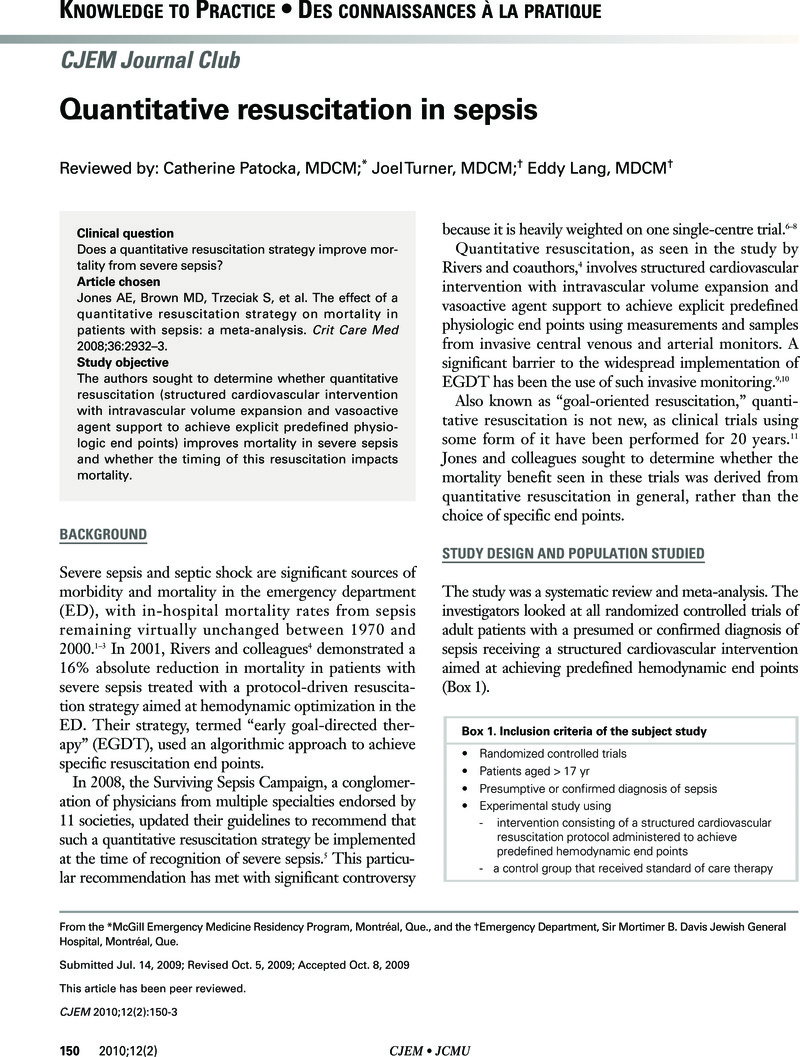No CrossRef data available.
Article contents
Quantitative resuscitation in sepsis
Published online by Cambridge University Press: 21 May 2015
Abstract
An abstract is not available for this content so a preview has been provided. As you have access to this content, a full PDF is available via the ‘Save PDF’ action button.

- Type
- Knowledge to Practice • Des connaissances à la pratique
- Information
- Copyright
- Copyright © Canadian Association of Emergency Physicians 2010
References
REFERENCES
1.Strehlow, MC, Emond, SD, Shapiro, NI, et al. National study of emergency department visits for sepsis, 1992 to 2001. Ann Emerg Med 2006;48:326–31.Google Scholar
2.Angus, DCMMF, Linde Zwirble, WT, Lidicker, JM, et al. Epidemiology of severe sepsis in the United States: analysis of incidence, outcome, and associated costs of care. Crit Care Med 2001;29:1303–10.Google Scholar
3.Kochanek, KD, Smith, BL. Deaths: preliminary data for 2002. Natl Vital Stat Rep 2004;52:1–47.Google Scholar
4.Rivers, E, Nguyen, B, Havstad, S, et al. Early goal-directed therapy in the treatment of severe sepsis and septic shock. N Engl J Med 2001;345:1368–77.CrossRefGoogle ScholarPubMed
5.Dellinger, RP, Levy, MM, Carlet, JM, et al. Surviving Sepsis Campaign: international guidelines for management of severe sepsis and septic shock: 2008. Crit Care Med 2008;36:296–327.Google Scholar
6.Ho, BC, Bellomo, R, McGain, F, et al. The incidence and outcome of septic shock patients in the absence of early-goal directed therapy. Crit Care 2006;10:R80.Google Scholar
7.Peake, S, Webb, S, Delaney, A. Early goal-directed therapy of septic shock: We honestly remain skeptical. Crit Care Med 2007;35:994.Google Scholar
8.Sarkar, S, Kupfer, Y, Tessler, S. Goal-directed therapy for severe sepsis. N Engl J Med 2002;346:1025.Google Scholar
9.Carlbom, DJ, Rubenfeld, GD. Barriers to implementing protocol based sepsis resuscitation in the emergency department ― results of a national survey. Crit Care Med 2007;35:2525–32.Google Scholar
10.Trzeciak, S, Dellinger, RP, Abate, NL, et al. Translating research to clinical practice: a 1-year experience with implementing early goal-directed therapy for septic shock in the emergency department. Chest 2006;129:225–32.CrossRefGoogle ScholarPubMed
11.Shoemaker, WC, Appel, PL, Kram, HB, et al. Prospective trial of supranormal values of survivors as therapeutic goals in high-risk surgical patients. Chest 1988;94:1176–86.CrossRefGoogle ScholarPubMed
12.Moher, D, Cook, DJ, Eastwood, S, et al.; QUOROM Group. Improving the quality of reports of meta-analyses of randomised controlled trials: the QUOROM statement. Lancet 1999;354:1896–900.Google Scholar
13.Lin, SM, Lin, HC, Liu, CY, et al. A modified goal-directed protocol improves clinical outcomes in intensive care unit patients with septic shock: a randomized controlled trial. Shock 2006;26:551.Google Scholar
14.Alia, I, Esteban, A, Gordo, F, et al. A randomized and controlled trial of the effect of treatment aimed at maximizing oxygen delivery in patients with severe sepsis or septic shock. Chest 1999;115:453–61.Google Scholar
15.Yu, M, Burchell, S, Hasaniya, NWMA, et al. Relationship of mortality to increasing oxygen delivery in patients > or = to 50 years of age: a prospective, randomized trial. Crit Care Med 1998;26:1011.CrossRefGoogle ScholarPubMed
16.Yu, M, Levy, MM, Smith, P, et al. Effect of maximizing oxygen delivery on morbidity and mortality rates in critically ill patients: a prospective, randomized, controlled study. Crit Care Med 1993;21:830.Google Scholar
17.Tuchschmidt, J, Fried, J, Astiz, M, et al. Elevation of cardiac output and oxygen delivery improves outcome in septic shock. Chest 1992;102:216–20.Google Scholar
18.Green, RS, Djogovic, D, Gray, S, et al. Canadian Association of Emergency Physicians sepsis guidelines: the optimal management of severe sepsis in Canadian emergency departments. CJEM 2008;10:443–59.Google Scholar
19.National Institute of General Medical Sciences (NIGMS). Lactate assessment in the treatment of early sepsis: the Lact ATES Trial. Bethesda (MD): National Library of Medicine; 2000. Available: http://clinicaltrials.gov/show/NCT00372502 (accessed 2010 Jan 26). NLM Identifier: NCT00372503.Google Scholar
20.National Institute of General Medical Sciences (NIGMS); University of Pittsburgh. Protocolized care for early septic shock (ProCESS). Bethesda (MD): National Library of Medicine; 2000. Available: http://clinicaltrials.gov/show/NCT00510835 (accessed 2010 Feb 1). NLM Identifier: NCT 00510835.Google Scholar




